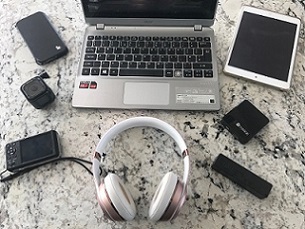 Passengers take all kinds of battery-powered devices on board tourist marine craft. Image from free photo website Pixabay.
Passengers take all kinds of battery-powered devices on board tourist marine craft. Image from free photo website Pixabay.
 Yachts moored up in Italy. Image by Domenico Farone on free photo website Pixabay.
Yachts moored up in Italy. Image by Domenico Farone on free photo website Pixabay.
 All these everyday devices are powered by lithium-ion batteries
All these everyday devices are powered by lithium-ion batteries
 A pilot holding an AvSax lithium battery fire containment bag
A pilot holding an AvSax lithium battery fire containment bag
 Many airlines are ready to deal with lithium battery fires in the confined spaces of aircraft passenger compartments
Many airlines are ready to deal with lithium battery fires in the confined spaces of aircraft passenger compartments
Several luxury yachts have been damaged or destroyed by intense fires sparked by lithium batteries.
And there are fears that an increasing number of pleasure boats and tourist submarines are at risk from fire caused by the personal electronic devices such as mobile phones and iPads that passengers bring on board.
If batteries overheat or become faulty they go into what’s known as thermal runaway with the fire going rapidly from cell to cell to the point flames shoot out and the device even exploding.
During thermal runaway the battery can produce heat up to 900°C (1652°F) making it very difficult to extinguish, especially as it doesn’t need oxygen to keep flaring up.
One of the worst maritime disasters in USA history happened in September 2019 when 34 people died after a dive boat, Conception, caught fire off the Californian coast and the blaze spread rapidly. It’s thought the cause may have been because too many people were charging electronic devices which overloaded the system and, after the disaster, the Coast Guard quickly advised owners, operators and masters of passenger vessels to limit “the unsupervised charging of lithium-ion batteries and extensive use of power strips and extension cords.”
Another case was the destruction of the super yacht Kanga near Dubrovnik in Croatia in September 2018 which is thought to have been caused by a lithium battery being charged to power an electric surfboard.
The main advice now is to never charge an electronic device on a boat at night when everyone is asleep. Only charge them when someone is nearby so can react quickly if they go into thermal runaway.
The danger has been brought into focus with the number of fires on passenger aircraft caused by lithium batteries overheating, smouldering, catching fire or even exploding on board. Up to the start of June 2022, the Federal Aviation Administration (FAA) in the USA has recorded 373 aviation-related incidents involving lithium batteries carried as cargo or baggage since January 23, 2006. Many more incidents will have happened in other parts of the world as the FAA only covers US aircraft and incidents in US airspace.
More than 100 airlines, including some of the biggest names in the industry, now have AvSax lithium battery fire mitigation bags on board and every time there has been a problem with a device it has been placed in the bag and the aircraft has landed safely.
The danger is also ever present at sea, especially on boats which have many people on board.
Just about every electronic device you can think of – headphones, vapes, e-cigarettes, cameras and cellphones – are powered by lithium batteries and people plug them in to recharge them.
Problems can be caused if the chargers don’t meet safety standards, the batteries have become damaged if, say, the device had been dropped on the ground or a plug socket is overloaded.
A smouldering device could spark a fire which can rapidly escalate and quickly engulf the yacht or boat.
If the device is put in an AvSax then it’s safely contained and, if it then cools down, it would still work and the person would still be able to get all their data off it.
AvSax were invented by Richard Bailey, managing director of Environmental Defence Systems Ltd based in Yorkshire, UK.
He said: “The danger of lithium batteries potentially catching fire is ever present with potentially catastrophic consequences if this happened on a tourist submarine underwater or in the confined space of cabins below deck on yachts and pleasure boats. More and more devices are powered by the batteries so it’s always best to be prepared.”
Lithium-ion batteries are regulated as a hazardous material (dangerous goods) for all modes of transportation and some container ships have even caught fire with the blazes sparked by lithium batteries in the cargo.
Lithium battery fires are very dangerous as they can continue to burn even when starved of oxygen and can flare up again hours later.
AvSax lithium battery fire mitigation bags are now on board more than 100 airline companies operating 16,770 aircraft worldwide – including some of the biggest names in the industry. AvSax are the most widely deployed battery ‘burnbags’ on aircraft by far and won the Queen’s Award for Enterprise in the UK for their innovation which is the highest award any business can get.
AvSax thermal containment bags are unique in that they are designed to continually cool the overheating battery by adding water into the bag once the device has been put in there.
The water is absorbed into the sides of the bag which then expand and close in around the device, stifling any potential flare-up. The bag is made of military-grade material which means it can withstand the force of a blast even if the device explodes.
This use of liquid is recommended by the Civil Aviation Authority (CAA) in the UK and many other fire containment bags don’t work this way.
In its guidance the CAA states: “Since the development of the International Civil Aviation Organization (ICAO) guidance on dealing with an in-flight battery fire, new products designed for use in response to lithium battery thermal runaway events have become available.
“Products which provide both a cooling and containment capability are typically more aligned to the existing ICAO guidance as when used they are filled with water or other non-flammable liquid to act as a cooling agent.
“After knocking down flames it could conceivably take just a couple of seconds for a personal electronic device to be placed inside a containment bag, allowing it to be moved to a place of safety.”
AvSax have been used 33 times to deal with emergencies since the start of 2017 and every time they have been deployed the aircraft has been able to complete its journey safely with no need to divert or make an emergency landing. Diversions can be very costly to the airline company and can even run into hundreds of thousands of dollars.